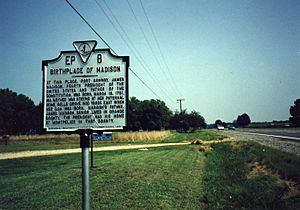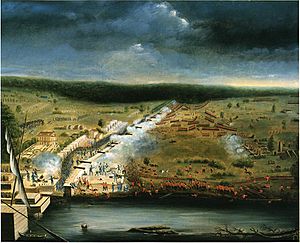James Madison facts for kids
Quick facts for kids
James Madison
|
|
|---|---|
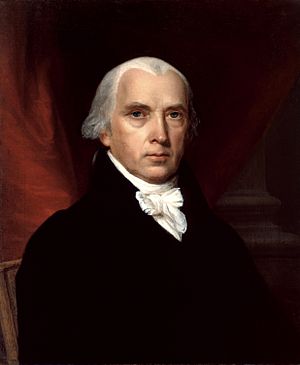 |
|
| 4th President of the United States | |
| In office March 4, 1809 – March 3, 1817 |
|
| Vice President | George Clinton; Elbridge Gerry |
| Preceded by | Thomas Jefferson |
| Succeeded by | James Monroe |
| Personal details | |
| Born | March 16, 1751 Port Conway, Virginia, U.S. |
| Died | June 28, 1836 (aged 85) Montpelier, Virginia, U.S. |
| Nationality | American |
| Political party | Democratic-Republican |
| Height | 5 ft 4 in (1.63 m) |
| Spouse | Dolley Todd Madison |
| Signature | |
James Madison (March 16, 1751 – June 28, 1836) was the fourth President of the United States. He is often called the "Father of the Constitution" because he helped write a big part of the U.S. Constitution. He also played a key role in creating the Bill of Rights.
Madison was a close friend and advisor to the first president, George Washington. He even helped Washington write his first speech as president. Many places and buildings are named after Madison. These include Madison Square Garden, James Madison University, and the James Madison Memorial Building.
Contents
Early Life and Education
James Madison, Jr. was born on March 16, 1751. His birthplace was Belle Grove Plantation near Port Conway in Virginia. His parents were James Madison Sr. and Nelly Conway Madison. He was the oldest of twelve children. However, only six of his siblings lived to be adults.
His father was a tobacco planter. In the early 1760s, the Madison family moved to a new house. They named this house Montpelier.
From age 11 to 16, Madison had a Scottish teacher named Donald Robertson. This teacher tutored children from important families in the South. Madison learned math, geography, and many languages. He became very good at Latin. Madison graduated from Princeton in 1771. After college, he returned home and taught his younger brothers and sisters.
Political Career and the Constitution
Even though Madison did not fight in the Revolutionary War, he became an important leader in Virginia. He served in the Virginia House of Delegates and the Continental Congress. These roles were during and after the American Revolutionary War.
Madison helped organize the Constitutional Convention. This meeting created the U.S. Constitution we have today. Because of his big role, Madison is known as the "Father of the Constitution." On July 4, 1776, the United States Declaration of Independence was printed. This declared the 13 American states a new, independent nation.
Madison later joined the Virginia governor's Council of State. There, he became a close friend of Governor Thomas Jefferson. Madison helped Jefferson start the Democratic–Republican Party. This party was against Hamilton's Federalist Party. When Jefferson became president in 1800, Madison served as his Secretary of State from 1801 to 1809.
Creating the Bill of Rights
Madison suggested several changes to the Constitution. These changes became the Bill of Rights. His ideas included many limits on the federal government. They would protect important freedoms like freedom of religion and freedom of speech. They also protected the right to gather peacefully. Madison was also key in proposing freedom of the press and the right to jury trials.
To prevent a powerful federal army, Madison proposed the Second Amendment. This gave state-regulated militia groups and private citizens the "right to bear arms." Madison's Bill of Rights was widely accepted. Ten amendments were approved on December 15, 1791. They are now known as the Bill of Rights.
Presidency and the War of 1812
Madison was chosen by his party to run for president in 1808. He won that election and then won again in 1812.
The War of 1812
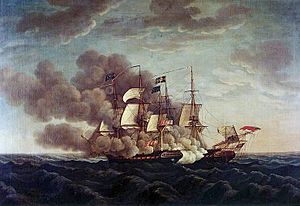
The War of 1812 began while Madison was president. At first, Madison thought the U.S. would win quickly. However, the British army was very organized. They used professional soldiers and teamed up with Native American tribes led by Tecumseh. Madison struggled to pay for the war.

In 1814, British forces took over Washington D.C. They burned the White House and many other buildings. Madison and his family had to flee. After this bad start, Madison accepted Russia's offer to help make peace. He sent a group to Europe to work on a peace treaty. The Treaty of Ghent was signed on December 24, 1814. It was approved by the U.S. Senate on February 16, 1815.
The war showed Madison that the federal government needed to be stronger. He oversaw the creation of the Second Bank of the United States. He also helped pass the Tariff of 1816, which protected American businesses.
Native American Policy
As president, Madison wanted to open more land for white American settlers. In 1809, he agreed to the Treaty of Fort Wayne. This treaty was signed with the Potawatomie, Delaware, Eel Rivers, and Miami tribes. The tribes received goods and money in exchange for about 3 million acres of land.
However, many tribes were unhappy with this treaty. They did not want to sell their land. Tecumseh, a Shawnee leader, was very angry. He famously asked, "Sell a country! Why not sell the air, the clouds and the great sea, as well as the earth?"
Tensions grew, leading to battles like the Battle of Tippecanoe. This period is sometimes called Tecumseh's War. Tecumseh was defeated, and Native Americans were pushed off their lands. White settlers then took over these areas. Other conflicts also occurred, such as the Peoria War and the Creek War. After the Creek War, the Treaty of Fort Jackson in 1814 added about 23 million acres of land to the United States. This land was in Georgia and Alabama.
Life After the Presidency (1817–1836)
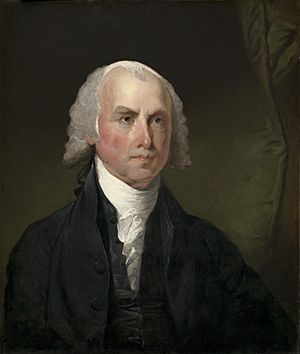
When Madison left office in 1817 at age 65, he went back to his home, Montpelier. This was not far from Jefferson's home, Monticello. Like Washington and Jefferson, Madison was poorer after being president. His plantation faced money problems due to lower tobacco prices and his stepson's poor management.
In his retirement, Madison sometimes helped with public matters. He helped Jefferson start the University of Virginia. In 1826, after Jefferson died, Madison became the university's second leader. He held this position for ten years until his death in 1836.
In 1829, at age 78, Madison was chosen to help revise Virginia's constitution. This was his last public appearance as a statesman.
Personal Life
On September 15, 1794, Madison married Dolley Payne Todd. She was a 26-year-old widow. Dolley became very famous in Washington, D.C. She was excellent at hosting dinners and other important political events. She helped shape the role of the First Lady of the United States.
Madison never had his own children. However, he adopted Dolley's son, John Payne Todd, after they married. When he was 50, Madison inherited his family's large plantation, Montpelier. This included many enslaved African Americans. Madison believed in treating enslaved people humanely. He made sure they had milk cows and enough food.
Death
James Madison died on June 28, 1836, at age 85. He passed away from heart failure. He was buried in the family cemetery at Montpelier.
It is said that on his last morning, he tried to eat breakfast but could not swallow. His favorite niece asked him what was wrong. Madison replied, "Nothing more than a change of mind, my dear." He died right after saying this.
Memorials
Montpelier, the Madison family's plantation, is now a National Historic Landmark. The James Madison Memorial Building is part of the Library of Congress. It serves as an official memorial to Madison. In 1986, the James Madison Memorial Fellowship Foundation was created. This was part of the 200th anniversary of the Constitution.
Other memorials include Madison, Wisconsin and Madison County, Alabama, both named after him. Madison Square Garden, James Madison University, and the USS James Madison are also named in his honor. In 2021, the Madison Metropolitan School District renamed James Madison Memorial High School. This happened because the community did not want to honor someone who used enslaved labor.
Interesting Facts About James Madison
- Madison's family had lived in Virginia since the mid-1600s.
- At five feet, four inches tall, Madison was the shortest U.S. president.
- Madison never weighed more than 100 pounds.
- Madison's wife, Dolley Madison, is famous for saving a portrait of George Washington during the War of 1812.
- He left money to the American Colonization Society, Princeton, and the University of Virginia.
- Throughout his life, Madison owned over one hundred African American enslaved people.
- After Madison's death, Dolley sold Montpelier and the remaining enslaved people to pay off debts.
James Madison Quotes
- "The purpose of the Constitution is to restrict the majority's ability to harm a minority."
- "If man is not fit to govern himself, how can he be fit to govern someone else?"
- "If men were angels, no government would be necessary."
Images for kids
-
First page of the original handwritten U.S. Constitution.
-
Gouverneur Morris signs the Constitution. Madison sits near Robert Morris.
-
Thomas Jefferson founded the Democratic-Republican Party with Madison.
-
Montpelier, Madison's plantation in Virginia.
-
A life-sized statue of Madison at James Madison University.
See also
 In Spanish: James Madison para niños
In Spanish: James Madison para niños


